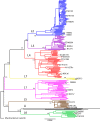Reference set of Mycobacterium tuberculosis clinical strains: A tool for research and product development
- PMID: 30908506
- PMCID: PMC6433267
- DOI: 10.1371/journal.pone.0214088
Reference set of Mycobacterium tuberculosis clinical strains: A tool for research and product development
Abstract
The Mycobacterium tuberculosis complex (MTBC) causes tuberculosis (TB) in humans and various other mammals. The human-adapted members of the MTBC comprise seven phylogenetic lineages that differ in their geographical distribution. There is growing evidence that this phylogeographic diversity modulates the outcome of TB infection and disease. For decades, TB research and development has focused on the two canonical MTBC laboratory strains H37Rv and Erdman, both of which belong to Lineage 4. Relying on only a few laboratory-adapted strains can be misleading as study results might not be directly transferrable to clinical settings where patients are infected with a diverse array of strains, including drug-resistant variants. Here, we argue for the need to expand TB research and development by incorporating the phylogenetic diversity of the MTBC. To facilitate such work, we have assembled a group of 20 genetically well-characterized clinical strains representing the seven known human-adapted MTBC lineages. With the "MTBC clinical strains reference set" we aim to provide a standardized resource for the TB community. We hope it will enable more direct comparisons between studies that explore the physiology of MTBC beyond the laboratory strains used thus far. We anticipate that detailed phenotypic analyses of this reference strain set will increase our understanding of TB biology and assist in the development of new control tools that are broadly effective.
Conflict of interest statement
The authors have declared that no competing interests exist.
Figures

References
-
- WHO. World Health Organization. Global tuberculosis control—surveillance, planning, financing. (WHO, Geneva, Switzerland, 2017). 2017.
-
- Homolka S, Niemann S, Russell DG, Rohde KH. Functional genetic diversity among Mycobacterium tuberculosis complex clinical isolates: delineation of conserved core and lineage-specific transcriptomes during intracellular survival. PLoS Pathog. 2010;6(7):e1000988 10.1371/journal.ppat.1000988 - DOI - PMC - PubMed
Publication types
MeSH terms
LinkOut - more resources
Full Text Sources
Other Literature Sources

